It is convenient at times to represent the cyclic structures of a monosaccharide without specifying whether the configuration of the anomeric carbon atom is . When we do this, we shall use formulas such as the following :
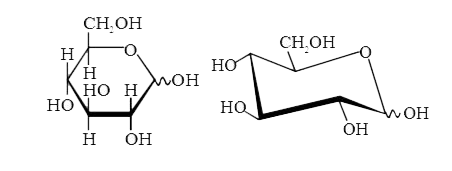
(three-dimensional view not specified)
What is the structure of L-Glucose ?


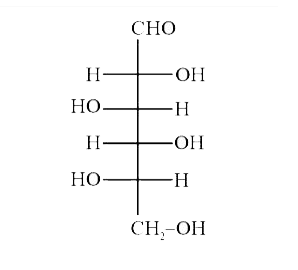
None of these
The correct Answer is:A
Topper's Solved these Questions
- BIOMOLECULES & POLYMERSBOOK - MOTIONCHAPTER - BIOMOLECULES & POLYMERSEXERCISE - EXERCISE - 4 (LEVEL I)
26 Videos
- BIOMOLECULES & POLYMERSBOOK - MOTIONCHAPTER - BIOMOLECULES & POLYMERSEXERCISE - EXERCISE - 4 (LEVEL II)
17 Videos
- BIOMOLECULES & POLYMERSBOOK - MOTIONCHAPTER - BIOMOLECULES & POLYMERSEXERCISE - EXERCISE - 2 ( LEVEL - II SECTION D)
4 Videos
- ATOMIC STRUCTURE BOOK - MOTIONCHAPTER - ATOMIC STRUCTURE EXERCISE - EXERCISE-4 (LEVEL-II)
18 Videos
- CARBONL COMPOUNDSBOOK - MOTIONCHAPTER - CARBONL COMPOUNDSEXERCISE - EXERCISE - 4 LEVEL -II
24 Videos
Similar Questions
Write the synonym of the word. Audacity
View SolutionMonosaccharides are polyhydric aldehydes and ketones which cannot be hydrolysed into simpler carbohydrates. The monosaccharides containing −CHO group are called aldoses while those containing C=O group are called ketoses. The aldehyde group is always present at C1 while keto group is generally present at C2. All monosaccharides are oxidised by Tollen's reagent and Fehling solution and are called reducing sugars.
The monosaccharide molecules may be assigned D and L-configurations depending upon whether the configuration of the molecule is related to D- or L-glyceraldehyde. If the −OH group is attached to the carbon adjacent to the −CH2OH group (last chiral carbon) is on the right hand side, it is assigned D-configuration. The molecule is assigned L-configuration if the -OH group attached to the carbon adjacent to the −CH2OH group is on the left. The monosaccharides contain one or more chiral carbon atoms. Pentoses and hexoses have cyclic structures furanose (five membered) and pyranose (six membered). During cyclization, C1 in aldohexoses and C2 in fructose become chiral and the newly formed -OH group may be either on the left or on the right in Fischer projection formulae. These monosaccharides, therefore, exist in two stereoisomeric forms called α-anomer and β-anomer while C1andC2 are called glycosidic or anomeric carbon. The bonds joining glycosidic carbon are called glycosidic linkages. D(+) glucose exists in two stereoisomeric forms, α-D- glucose and β-D-glucose. When either of these two forms of glucose i.e., α−D−glucose are dissolved in water and allowed to stand, these get slowly converted into other form and an equilibrium mixture of both is formed. This process is called mutarotation.
The maximum number of optical isomers of glucose expected are
View Solution
Knowledge Check
It is convenient at times to represent the cyclic structures of a monosaccharide without specifying whether the configuration of the anomeric carbon atom is α or β. When we do this, we shall use formulas such as the following :
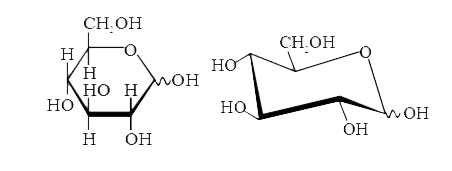
~ Indicates α or β (three-dimensional view not specified)
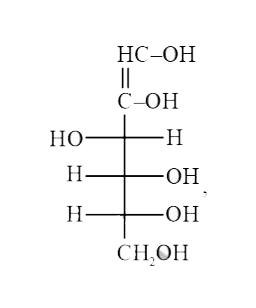
the given is enol form ofAD-glucoseBD-mannoseCD-FructoseDNone of theseIt is convenient at times to represent the cyclic structures of a monosaccharide without specifying whether the configuration of the anomeric carbon atom is α or β. When we do this, we shall use formulas such as the following :
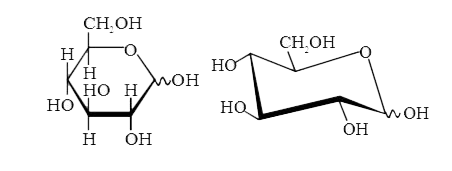
~ Indicates α or β (three-dimensional view not specified)
Which of the following represents the anomer of the compound shwon ?
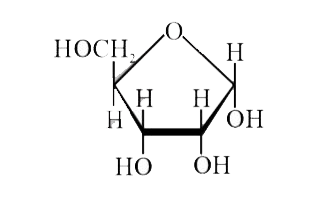 A
A B
B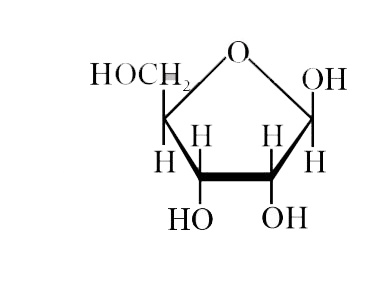 C
C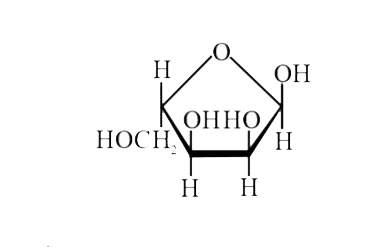 DNone of these
DNone of theseRead the following passages carefully and answer the questions that follow.
Why do poets use poems to tell about social injustices? The answer is simple. This way a poet can catch and hold the reader's attention, his/her emotions. Usually poets in their works present facts in order to capture attention of many people. These are not new facts that are presented to an audience. Poems are always aimed at reaching feelings of people and thus, pulling strings. Literature of every state shows all the complexity of every epoch. When the situation is the same in several countries, it has a worldwide significance. Before talking about poetry, we should answer the question. What is poetry? Poetry is a special way of describing situations, things, ideas, feelings, Poets present their ideas in short phrases.
A poem can be compared to a photograph as it reflects real life situations and feelings. In a poem a poet captures the exact moment and represents it the way he/she has seen it. When you read a poem you see the poet's subjective evaluation of facts, situations and the epoch in general. Poets of the Romantic Movement wrote their poems to share their feelings. They wrote to help people understand their time from the poet's point of view.
The structure of poetry is usually characterisedAshort, factual stanzasBsequences of two or more words without an 'action word'Clong winded sentencesDlengthy descriptive stanzas
Monosaccharides are polyhydric aldehydes and ketones which cannot be hydrolysed into simpler carbohydrates. The monosaccharides containing −CHO group are called aldoses while those containing C=O group are called ketoses. The aldehyde group is always present at C1 while keto group is generally present at C2. All monosaccharides are oxidised by Tollen's reagent and Fehling solution and are called reducing sugars.
The monosaccharide molecules may be assigned D and L-configurations depending upon whether the configuration of the molecule is related to D- or L-glyceraldehyde. If the −OH group is attached to the carbon adjacent to the −CH2OH group (last chiral carbon) is on the right hand side, it is assigned D-configuration. The molecule is assigned L-configuration if the -OH group attached to the carbon adjacent to the −CH2OH group is on the left. The monosaccharides contain one or more chiral carbon atoms. Pentoses and hexoses have cyclic structures furanose (five membered) and pyranose (six membered). During cyclization, C1 in aldohexoses and C2 in fructose become chiral and the newly formed -OH group may be either on the left or on the right in Fischer projection formulae. These monosaccharides, therefore, exist in two stereoisomeric forms called α-anomer and β-anomer while C1andC2 are called glycosidic or anomeric carbon. The bonds joining glycosidic carbon are called glycosidic linkages. D(+) glucose exists in two stereoisomeric forms, α-D- glucose and β-D-glucose. When either of these two forms of glucose i.e., α−D−glucose are dissolved in water and allowed to stand, these get slowly converted into other form and an equilibrium mixture of both is formed. This process is called mutarotation.
Which of the following pairs give positive Tollen's test?
View SolutionMonosaccharides are polyhydric aldehydes and ketones which cannot be hydrolysed into simpler carbohydrates. The monosaccharides containing −CHO group are called aldoses while those containing C=O group are called ketoses. The aldehyde group is always present at C1 while keto group is generally present at C2. All monosaccharides are oxidised by Tollen's reagent and Fehling solution and are called reducing sugars.
The monosaccharide molecules may be assigned D and L-configurations depending upon whether the configuration of the molecule is related to D- or L-glyceraldehyde. If the −OH group is attached to the carbon adjacent to the −CH2OH group (last chiral carbon) is on the right hand side, it is assigned D-configuration. The molecule is assigned L-configuration if the -OH group attached to the carbon adjacent to the −CH2OH group is on the left. The monosaccharides contain one or more chiral carbon atoms. Pentoses and hexoses have cyclic structures furanose (five membered) and pyranose (six membered). During cyclization, C1 in aldohexoses and C2 in fructose become chiral and the newly formed -OH group may be either on the left or on the right in Fischer projection formulae. These monosaccharides, therefore, exist in two stereoisomeric forms called α-anomer and β-anomer while C1andC2 are called glycosidic or anomeric carbon. The bonds joining glycosidic carbon are called glycosidic linkages. D(+) glucose exists in two stereoisomeric forms, α-D- glucose and β-D-glucose. When either of these two forms of glucose i.e., α−D−glucose are dissolved in water and allowed to stand, these get slowly converted into other form and an equilibrium mixture of both is formed. This process is called mutarotation.
Which of the following statements is not correct?
View SolutionMonosaccharides are polyhydric aldehydes and ketones which cannot be hydrolysed into simpler carbohydrates. The monosaccharides containing −CHO group are called aldoses while those containing C=O group are called ketoses. The aldehyde group is always present at C1 while keto group is generally present at C2. All monosaccharides are oxidised by Tollen's reagent and Fehling solution and are called reducing sugars.
The monosaccharide molecules may be assigned D and L-configurations depending upon whether the configuration of the molecule is related to D- or L-glyceraldehyde. If the −OH group is attached to the carbon adjacent to the −CH2OH group (last chiral carbon) is on the right hand side, it is assigned D-configuration. The molecule is assigned L-configuration if the -OH group attached to the carbon adjacent to the −CH2OH group is on the left. The monosaccharides contain one or more chiral carbon atoms. Pentoses and hexoses have cyclic structures furanose (five membered) and pyranose (six membered). During cyclization, C1 in aldohexoses and C2 in fructose become chiral and the newly formed -OH group may be either on the left or on the right in Fischer projection formulae. These monosaccharides, therefore, exist in two stereoisomeric forms called α-anomer and β-anomer while C1andC2 are called glycosidic or anomeric carbon. The bonds joining glycosidic carbon are called glycosidic linkages. D(+) glucose exists in two stereoisomeric forms, α-D- glucose and β-D-glucose. When either of these two forms of glucose i.e., α−D−glucose are dissolved in water and allowed to stand, these get slowly converted into other form and an equilibrium mixture of both is formed. This process is called mutarotation.
Two forms of D-glucopyranose are called
View SolutionMonosaccharides are polyhydric aldehydes and ketones which cannot be hydrolysed into simpler carbohydrates. The monosaccharides containing −CHO group are called aldoses while those containing C=O group are called ketoses. The aldehyde group is always present at C1 while keto group is generally present at C2. All monosaccharides are oxidised by Tollen's reagent and Fehling solution and are called reducing sugars.
The monosaccharide molecules may be assigned D and L-configurations depending upon whether the configuration of the molecule is related to D- or L-glyceraldehyde. If the −OH group is attached to the carbon adjacent to the −CH2OH group (last chiral carbon) is on the right hand side, it is assigned D-configuration. The molecule is assigned L-configuration if the -OH group attached to the carbon adjacent to the −CH2OH group is on the left. The monosaccharides contain one or more chiral carbon atoms. Pentoses and hexoses have cyclic structures furanose (five membered) and pyranose (six membered). During cyclization, C1 in aldohexoses and C2 in fructose become chiral and the newly formed -OH group may be either on the left or on the right in Fischer projection formulae. These monosaccharides, therefore, exist in two stereoisomeric forms called α-anomer and β-anomer while C1andC2 are called glycosidic or anomeric carbon. The bonds joining glycosidic carbon are called glycosidic linkages. D(+) glucose exists in two stereoisomeric forms, α-D- glucose and β-D-glucose. When either of these two forms of glucose i.e., α−D−glucose are dissolved in water and allowed to stand, these get slowly converted into other form and an equilibrium mixture of both is formed. This process is called mutarotation.
Mutarotation does not occur in
View SolutionAll real structures are three dimensional structures. They can be obtained by stacking two dimensional layers one above the other while placing the second square dose packed layer above the first we follow the same rule that was followed when one row was placed adjacent to the other. The second layer is placed over the first layer such that the spheres of the upper layer are exactly above there of the first layer. In his arrangement spheres of both the layers are perfectly aligned horizontally as well as vertically. A metallic element crystallise into a lattice having a ABC ABC pattern and packing of spheres leaves out voids in the lattice.
What is the total volume of atoms in a face centred cubic unit cell of a metal? (r is atomic radius).
View Solution
